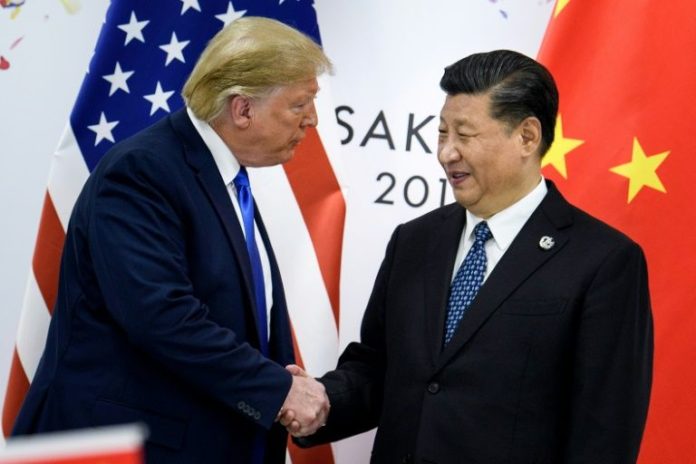Geneva, Nov (Kanaga Raja) – Tariffs being imposed by the United States on China are economically hurting both countries, with US losses largely related to higher prices for its consumers, while China’s losses are related to significant export losses, a new study by the UN Conference on Trade and Development (UNCTAD) says. According to the study, “Trade and trade diversion effects of United States tariffs on China”, United States tariffs on China have resulted in a decline in imports of tariffed products by about 25 percent in the first half of 2019.
While substantial, this figure also shows the competitiveness of Chinese firms, which despite the substantial tariffs, were still able to maintain 75 percent of their exports to the United States.
The paper quantified the trade diversion effects for the first half of 2019 to be about US$21 billion, implying that the amount of net trade losses corresponds to about US$14 billion.
Trade diversion effects have brought substantial benefits to Taiwan Province of China, Mexico, the European Union, and Viet Nam.
The paper found that the hardest hit sectors have been office machinery and communication equipment with a total reduction of United States imports from China in the order of about US$15 billion for the first half of 2019.
Trade diversion effects in these sectors have been below average possibly because of lack of supply capacity outside China, said the paper.
“The results of the study serve as a global warning. A lose-lose trade war is not only harming the main contenders, it also compromises the stability of the global economy and future growth,” said Ms Pamela Coke Hamilton, Director of the UNCTAD Division on International Trade and Commodities.
“We hope a potential trade agreement between the US and China can de-escalate trade tensions,” she added.
At a media briefing on Tuesday (5 November), Mr Alessandro Nicita, an economist at the UNCTAD Division on International Trade and Commodities and lead author of the paper, said the aim of the study was to provide some insights vis-a-vis three questions.
The first is what sector has been hit the most in the trade war in relation to the US tariffs imposed on China. Secondly, who is paying for these tariffs, and thirdly, who has benefited from the trade diversion.
Asked whether US President Donald Trump has succeeded in bringing jobs back to the US which was his goal in initiating the trade war with China, Mr Nicita said he did not think so, mainly due to the trade diversion effects.
“So if you really want to bring back manufacturing jobs, the bilateral tariffs is not really a good or the best instrument” because what will happen is that other countries will replace China and that is actually what we observe, he said.
According to the UNCTAD paper, economists generally agree that increases in bilateral trade costs, such as those resulting from the ongoing trade war between the United States and China, will result in lower trade, higher prices for consumers, and trade diversion effects.
By using recent import data from the United States census bureau, the paper said that it found empirical evidence for these arguments.
By adopting a simple identification strategy which relies on measuring differences in outcomes between goods that have been subject to additional tariffs versus goods that have not, and controlling for detailed sectoral specific effects, the paper found substantial evidence that United States tariffs have resulted in a strong decline in US imports from China.
The paper also found that such a decline was partly replaced by a surge in United States imports from elsewhere.
The analysis found implicit evidence that the cost of the tariffs has been generally passed down to United States consumers.
However, it also found some indication that Chinese firms may have only recently started to react to tariffs by reducing their export prices, thus absorbing part of the cost of the tariffs (about 8 percentage points).
However, the limited evidence found in this study would need to be substantiated by further data once it becomes available, said the paper.
Though the paper does not examine the impact of the most recent phase of the trade war, it warned that the escalation in summer of 2019 is likely to have added to the existing losses.
The analysis in the paper did not consider either the impact of Chinese tariffs on United States imports, but the qualitative results are most likely to be analogous: higher prices for Chinese consumers and losses for United States exporters.
BACKGROUND TO US-CHINA TRADE WAR
According to the paper, over the course of 2018, the United States administration started implementing a series of trade measures aimed at curtailing imports, first targeting specific products (steel, aluminum, solar panels and washing machines) and then specifically targeting imports from China.
The first phase of the United States-China trade confrontation occurred in the early summer of 2018 when the United States and China raised tariffs on about US$50 billion of each other’s goods.
The impossibility of finding common ground to resolve the issues of trade balances and intellectual property rights resulted in the further deterioration of United States-China trade relationship.
The United States administration introduced additional tariffs in September 2018 to cover US$200 billion of Chinese imports, to which China retaliated by imposing tariffs on imports from the United States worth an additional US$60 billion.
While these tariffs were initially due to rise from 10 to 25 percent in January 2019, in early December 2018 the parties agreed to hold off any retaliatory actions until March 2019.
This truce held until June 2019 when the United States went ahead with the planned increase in tariffs from 10 percent to 25 percent, to which China responded by raising the tariffs on a subset of the products which were already subject to tariffs.
The retaliation further escalated in September 2019 when the United States imposed 15 percent tariffs on a large subset of the remaining US$300 billion of imports from China not yet subject to tariffs. Further escalation is expected to take place in December 2019.
IMPACT OF US TARIFFS ON CHINA
The paper used updated and finely disaggregated data to investigate the impact of tariffs on United States imports and to answer three related questions: first, to what extent and when United States tariffs have reduced imports from China; second, whether United States tariffs have had any effect on China export prices; and third, to what extent United States tariffs on China have resulted in a surge of United States imports from elsewhere.
The paper analyzed the impact of the two initial phases of the United States-China trade war.
Phase one covers the products for which United States tariffs were initially raised in July 2018. Phase two covers the products for which United States tariffs were initially raised at the end of September 2018.
Phase one of United States tariff escalation involves about US$60 billion worth of imports from China, comprising about 1,100 HS 8-digit codes.
Phase two of United States tariffs on China covers about US$200 billion worth of imports from China, comprising about 6,000 HS 8-digit codes.
The United States tariff schedule comprises close to 11,000 HS8 tariff codes, thus phase one and two collectively cover about two-thirds of United States HS8 lines.
To investigate the effect of United States tariffs on China, the paper used trade data at the 8-digit level of the HS classification, representing more than 10,000 tariff lines. The analysis makes use of data from the first quarter of 2017 to the second quarter of 2019.
The paper noted that in 2018, the United States imported from China about US$550 billion worth of goods, US$255 billion of which was in the first half of 2018.
By comparison, the value of United States imports from China in the first half of 2019 was less than US$230 billion, corresponding to a decline of about 10 percent.
Chinese exports to the United States started to decline soon after the imposition of tariffs, especially for those products covered under phase one. For the products covered under phase two, the effects started to be evident from the first quarter of 2019.
By comparison, imports of goods not subject to tariffs have been relatively more stable and increased during Q2 2019.
According to the paper, one possible reason for such an increase in United States importers stockpiling due to the possibility of additional tariffs on the remaining products (which indeed happened in September 2019).
Another possible explanation is that Chinese exporters were trying to maintain profit margins by increasing exports in non-tariffed goods. Another possibility relates to mis-invoicing products to avoid tariffs.
According to the paper, office machinery has been the hardest hit sector in the trade war. In this category, the imports of products subject to additional tariffs dropped by 65 percent.
For other sectors, such as agri-food, communication equipment, and precision instruments, trade in the tariffed goods fell by more than 30 percent.
The paper found that one consequence of United States bilateral tariffs on China has been to increase United States imports from elsewhere.
The overall trade diversion effects observed in data for the first half of 2019 amount to about US$21 billion.
To put this figure in context, one needs to consider that the observed United States imports from China in goods under the list of products of phases one and two accounted for about US$130 billion in the first half of 2018, but only to about US$95 billion in the first half of 2019, resulting in a decline in United States imports from China of US$35 billion (or about 25 percent), said the paper.
Therefore, of the US$35 billion import loss, US$21 billion (or about 63%) has been replaced by imports originating from other countries, while the remainder of US$14 billion was lost due to lower demand in the United States and/or not enough capacity from the rest of the world.
The paper also noted that despite the tariffs, China has been able to preserve almost 75% of its trade in the products affected by tariffs.
Taiwan Province of China was the largest beneficiary of the trade diversion effects of United States tariffs on China, accounting for additional exports to the United States of almost US$4.2 billion in the first half of 2019.
For Taiwan Province of China, the benefits are largely related to an increase in exports of office machinery and communication equipment.
Mexico’s increase in exports to the United States due to tariffs on China is quantified to be about US$3.5 billion, mostly in the agri-food, transport equipment and electrical machinery sectors.
The European Union benefited by trade diversion effects of about US$2.7 billion, largely due to increases in exports in the machinery sectors.
Viet Nam’s benefits account to about US$2.6 billion and are mostly concentrated in communication equipment and furniture.
Trade diversion effects in favour of the Republic of Korea, Canada, and India were smaller but still substantial (between US$0.9 and US$1.5 billion).
The remainder of the trade diversion effects was largely to the advantage of other South-East Asian countries (US$1.7 billion).
The rest of Latin America, Sub-Saharan Africa and the rest of the world were only marginally able to benefit from trade diversion effects.
The paper underlined that office machinery has been the hardest hit sector in the ongoing trade war, with United States imports from China falling by almost US$10 billion in the first half of 2019.
Trade diversion effects for this sector are quantified to be about US$4.5 billion, most of which to the advantage of Taiwan Province of China.
This leaves about US$5.5 billion of trade losses, said the paper.
“Given the magnitude of the decline in United States imports from China, and the world market dominance of Chinese firms in this sector, the fact that other countries were not able to supply for the loss of imports from China is not a surprising outcome,” it added.
Communication equipment and furniture are two other sectors where the increase in imports from other countries were not sufficient to replace the decline in United States imports from China.
In these two sectors, Viet Nam exporters benefited the most.
Trade diversion effects in the machinery sectors have been more diverse, with a substantial share of the increase in United States imports coming not only from the East Asian region.
For these sectors, Mexico and the European Union were the major beneficiaries of the trade diversion effects, as well as Japan, said the paper.
– Third World Network




